It's a long haul from just about anywhere in Louisiana to get to Mansura.
Finding Hog Heaven at the Cochon de Lait Festival in Mansura, LA
Published May 2, 2018.
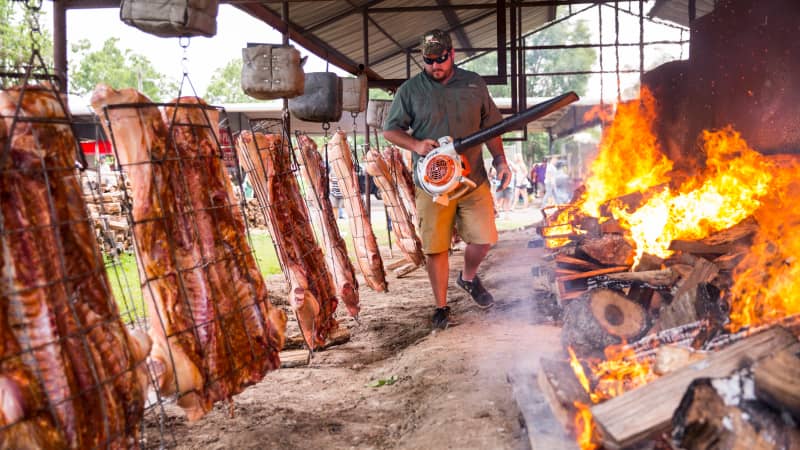
Located a three-hour drive from New Orleans, in Avoyelles Parish, the town is hidden in a winding maze of state highways that turn into progressively smaller and smaller rural routes. The view out your window slowly narrows from sprawling fields of impossibly flat land to fenced-in parks holding fleets of RVs, to four-way-stop intersections, each nearly empty but for the occasional farmstand or shuttered gas station.
Sign up for the Cook's Country Dinner Tonight newsletter
10 ingredients. 45 minutes. Quick, easy, and fresh weeknight recipes.
There’s no missing Mansura when you get to it, though, especially if you happen to be passing through during the second weekend in May. The streets are lined with cars pulled all the way into the front yards of single-level ranch houses, and a gigantic inflatable pig dressed in a chef’s toque and overalls waves to drivers passing the town fire department. No, you can’t miss it.

Unassuming though it may be, this small municipality in Cajun country claims the title of the Capital of the World of a certain preparation of roasted suckling pigs, an honor Mansurans have held for nearly six decades. For three days in the height of the humid Louisiana spring, a dedicated collective of local merchants stages the Cochon de Lait Festival, turning this sleepy hamlet into a bacchanalia celebrating this hyperlocal take on slow-cooked pork. This year marks the 44th annual festival, set for May 10-13, 2018.
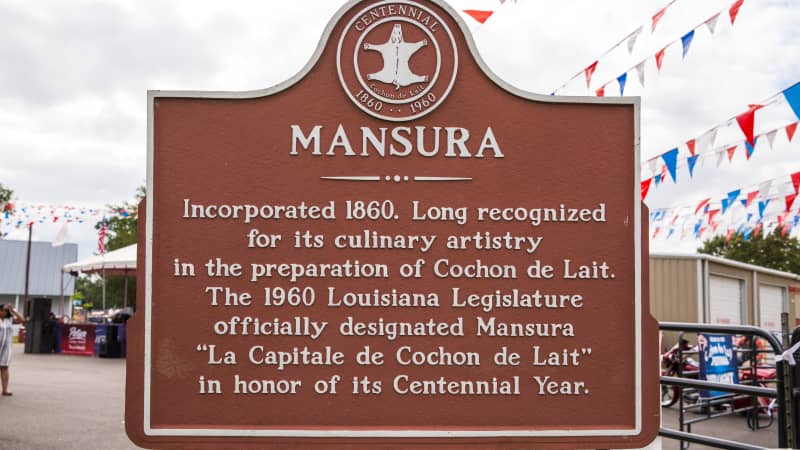
Taken from a French phrase that loosely translates to “pig fed on milk,” cochon de lait refers to cooking a butterflied suckling pig in a metal cage across from a roaring hardwood fire, sometimes as long as overnight. It’s a practice that hasn’t spread far from its mid-19th-century roots in this corner of Acadiana, but the end product carries an undeniable appeal: indescribably succulent meat held back by skin rendered to a burnished, rippling wall of crisp cracklins.
But cochon de lait is more than just a good meal: as anyone who’s ever attended a pig roast can tell you, what you do to pass the time while standing around waiting for the main course is just as important as the main course itself. It’s about people. The Cochon de Lait Festival leans heavily on that idea, rewarding those who make the journey to Mansura with a whole weekend of festivities before the first bite of roast pork is served on Sunday morning.
Contests made up a substantial portion of the festival’s Saturday schedule, from hog-calling to boudin-eating, and for many, winning was a matter of utmost seriousness.
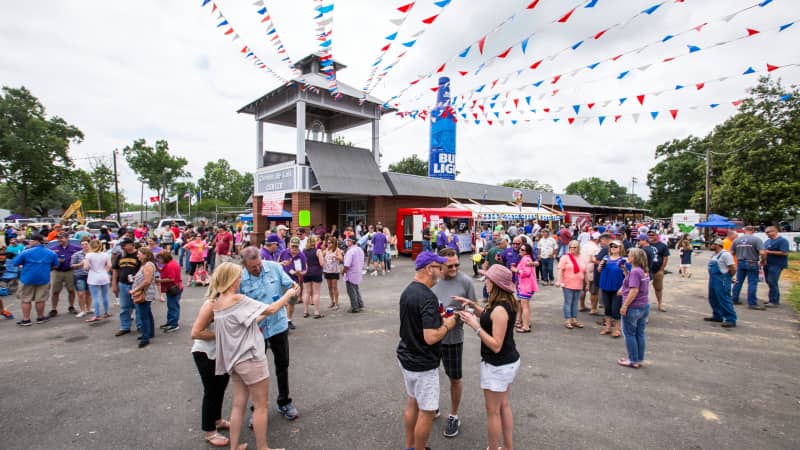
The festival centers around a pavilion dubbed the Cochon de Lait Center. (That’s right: there’s a brick-and-mortar structure dedicated to one weekend of pork-related revelry. Mansurans take this seriously.) Last year, we found attendees decked out in every shade of purple Louisiana State University apparel making the rounds in the parking lot under a canopy of small plastic flags, taking in the scene while trying to beat the heat with undersized cans of cold Bud Light.
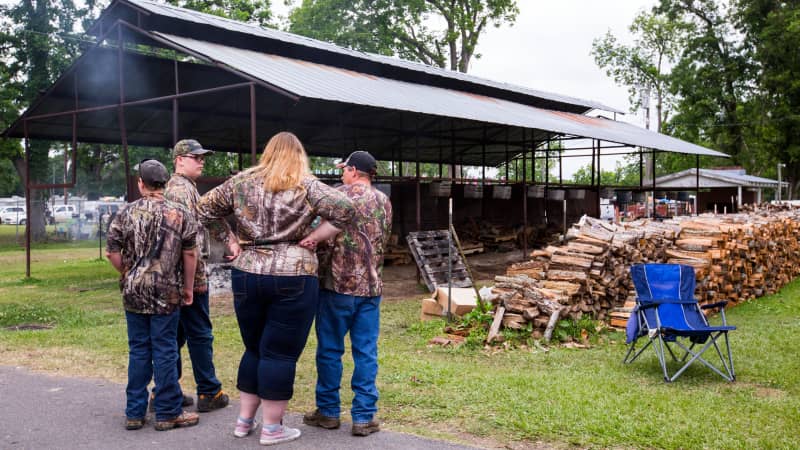
Toward the rear of the festival grounds stood a sixty-foot long framework of rusted iron pipes covered by a corrugated metal roof. Though this structure was empty but for a scattered pile of logs on Saturday morning, it would become a whirlwind of fire, smoke, and pork by late afternoon as the Cochon de Lait Festival’s namesake event began in earnest.
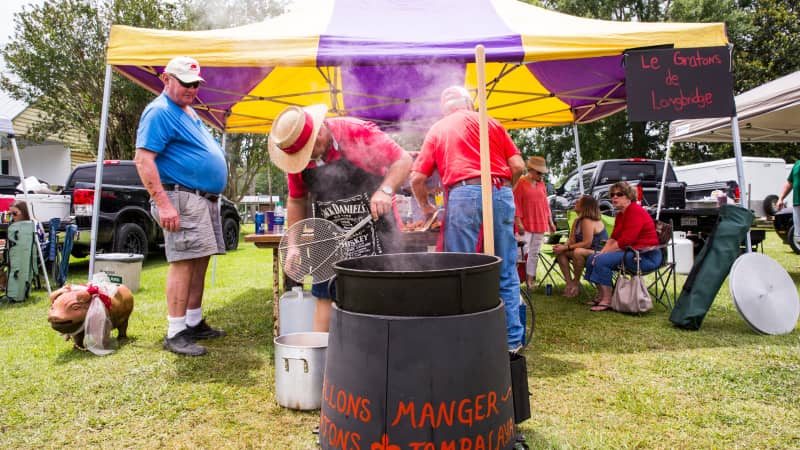
In the meantime, though, there was plenty of pig-related action to keep us busy. Not far from the woodpile, teams of local fried pork skin aficionados prepared their entries for the festival’s cracklin contest, shuffling their bounty in the baskets of wire spiders from blackened vats of hot fat to the shade of tailgate-style tents for closer analysis.
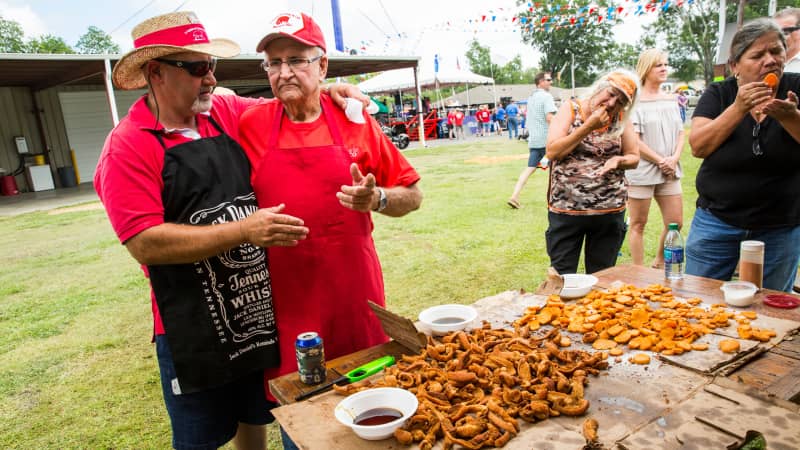
Thad Rabalais and his father, Gaston, made up one such team looking to wow the judges with their cracklins. Competing under the name “Le Gratons de Longbridge,” the Rabalais men drew a sizeable crowd of onlookers as they sorted through strip after strip of golden, bubbly pork skin on a grease-stained sheet of cardboard sitting atop a card table.
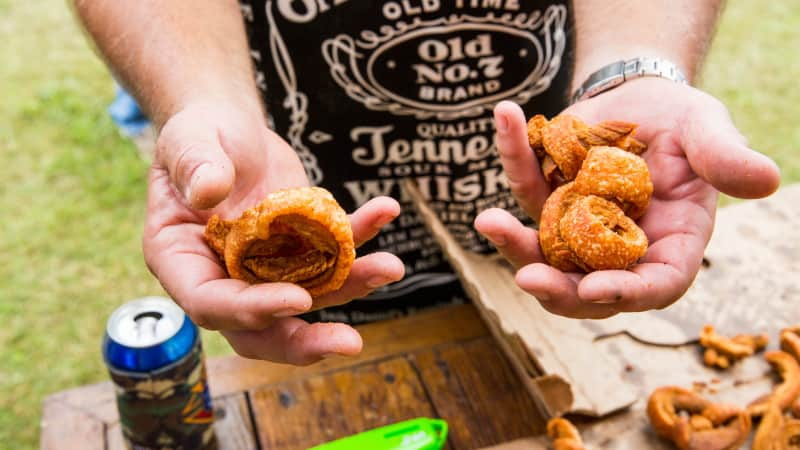
The ideal specimens boasted just the right amount of curl, a uniform golden color, and above all, a texture that starts out tantalizingly crunchy before the fat clinging to the underside of the skin starts to melt in your mouth. Out of their entire batch, fewer than a dozen cracklins would meet the Rabalais’ exacting criteria and earn the honor of being placed in a styrofoam clamshell container and handed off for judging.
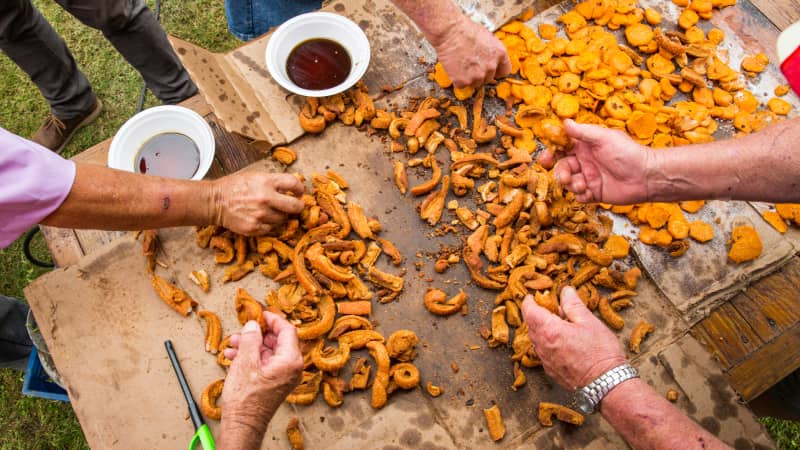
As for the remainder of the efforts of Le Gratons de Longbridge, onlookers were more than happy to do a little judging of their own, grabbing handfuls of crackln to dip into Styrofoam bowls of Steen’s Cane Syrup, a dirty-sweet invert sugar that serves as condiment of choice for cracklins in this part of Louisiana.
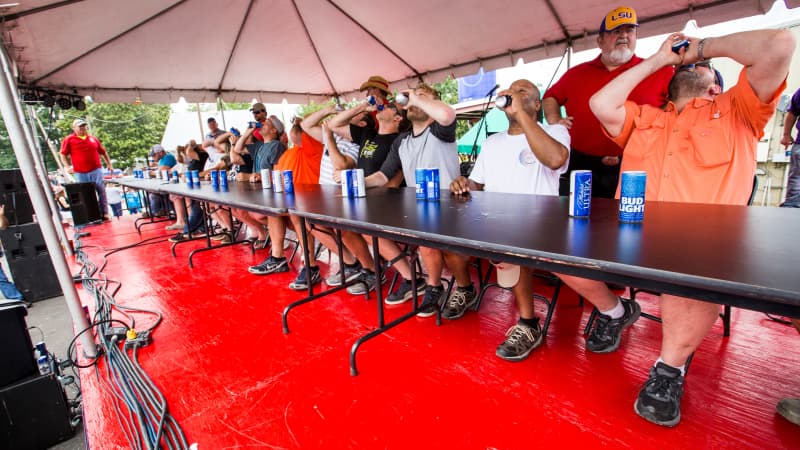
For those looking for a bit of hydration after snacking on cracklins, attendees needed look no further than the beer-drinking contests (ladies’ and mens’, in that order) held at the stage out front of the Cochon de Lait Center.

Contests made up a substantial portion of the festival’s Saturday schedule, from hog-calling to boudin-eating, and for many, winning was a matter of utmost seriousness. Here, the winner of the 2017 boudin-eating contest shows off his hardware from five years spent defending the title of the fastest pork-and-rice sausage consumer in Avoyelles Parish.
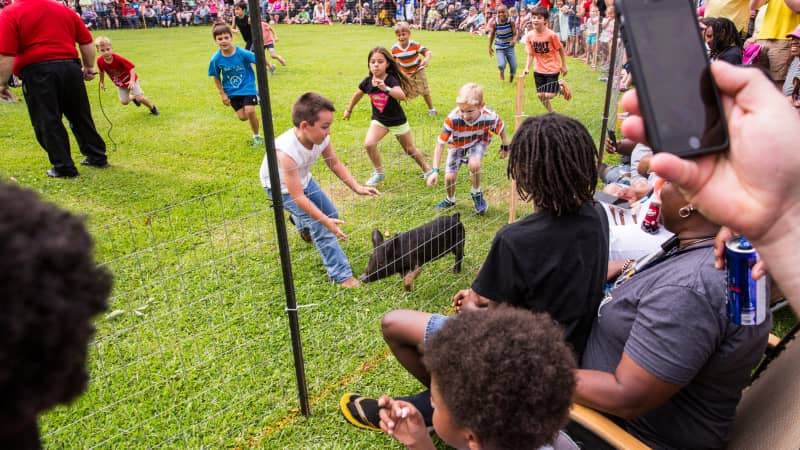
Perhaps the best-attended event of all, however, was the greasy pig contest, in which children chased an oiled-up piglet around a huge circular fenced-in enclosure, hoping to be the one to grab it in a bear hug and take it home at the end of the day.
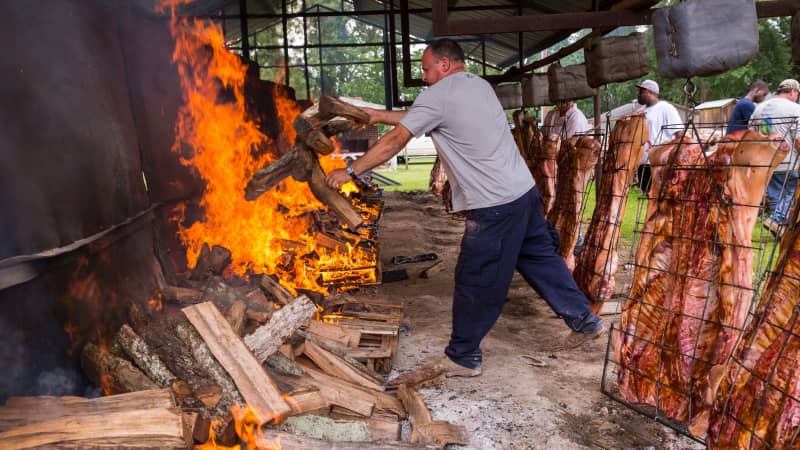
If lighter fluid didn’t do the job, though, there were other ways of heating things up: namely, using a cordless leaf blower as a high-powered bellows. It was Cajun ingenuity at its finest.
Meanwhile, at the other end of the festival grounds, it was finally time to kick off the main event and begin the act of cochon de lait. The cleaned hogs were placed in their cages and suspended from hooks attached to small motors housed in heatproof insulated boxes, and workers set about building a roaring fire, throwing armfuls of wood into a blazing pile stacked against a worn metal divider running down the center of the cookhouse.
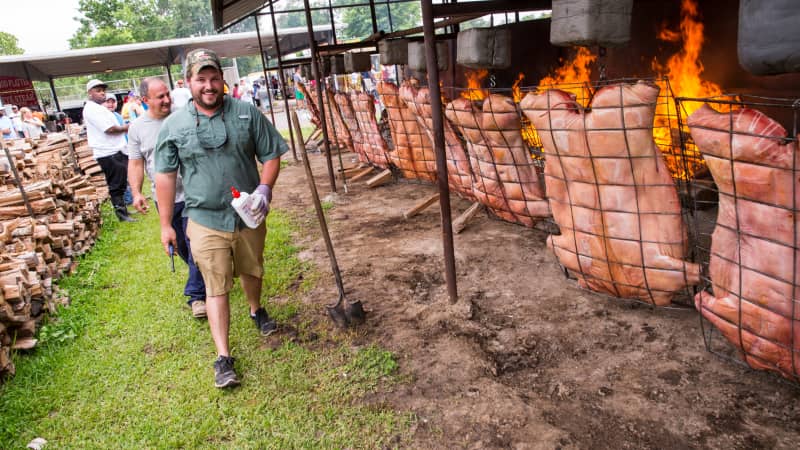
The man overseeing the roast, Zack St. Romain, paced the narrow lane of grass between the woodpile and the pigs. Bottle of lighter fluid in hand, he kept an eye out for any spots along the fire that needed a little assistance, applying a squirt here or there as necessary.

If lighter fluid didn’t do the job, though, there were other ways of heating things up: namely, using a cordless leaf blower as a high-powered bellows. St. Romain strode down the line of burning logs, stopping every few feet to put on his wraparound sunglasses and inject a blast of air into the heart of the fire, sending sparks flying from the lumber and turning what had to that point been a modestly-sized blaze into a furnace. It was Cajun ingenuity at its finest.
St. Romain and his team would tend the fire through the night, moving the hogs closer or further from the flames as necessary, waiting for the sunrise to signal the start of the second stage of cochon de lait: the breakdown.
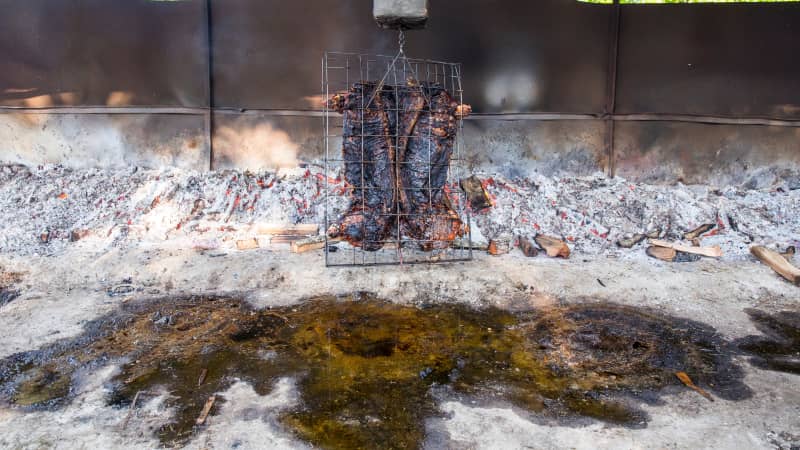
After sixteen hours, the fire had died down to a banked, grey pile of embers, and the pigs, now beautifully blackened, hung above pools of golden rendered fat on the ash-strewn ground.
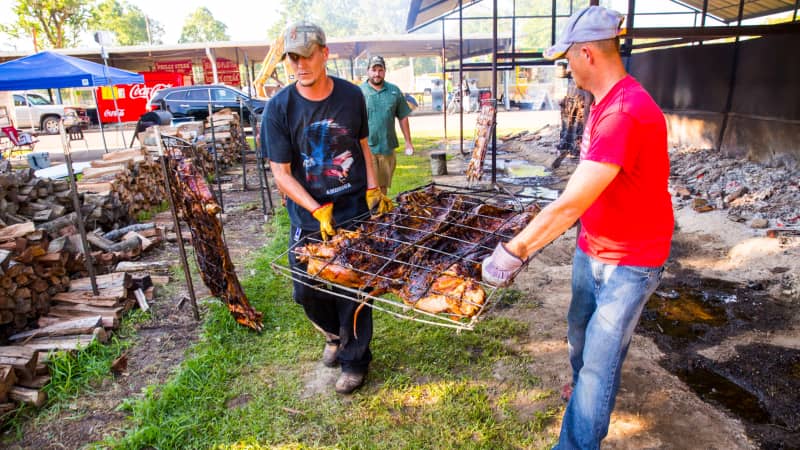
Workers lifted the last of the caged hogs from their hooks, carrying them one by one from the cookhouse as they finished, leaning them up against metal posts driven into the ground to rest before being broken down.
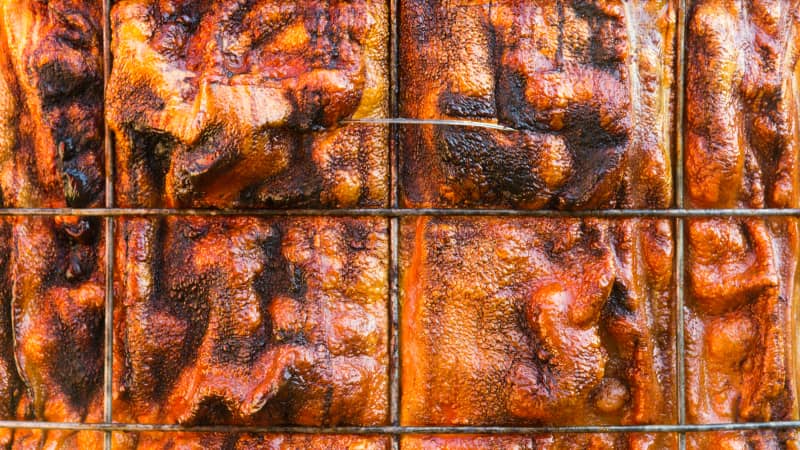
It’s at this point that the benefits of the cochon de lait method became apparent. When butterflied and roasted, one entire side of each pig becomes an undulating sheet of shining mahogany skin, rendered to a crisp shell of pure porky indulgence over hours spent next to a live fire. For pig roast enthusiasts, this is the pinnacle of the medium, cracklin elevated to an art form, the Night Watch of pork rinds.
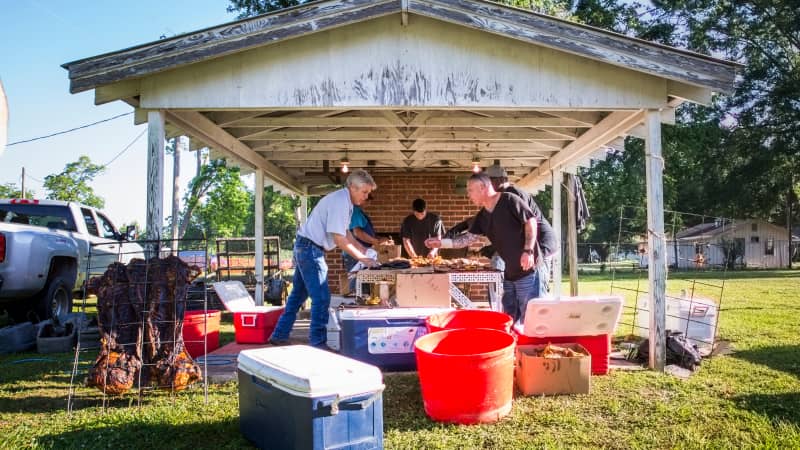
Once the hogs had rested, they were moved over to a lean-to across from the cookhouse, where a team of five early risers set about picking each one clean of its tender, succulent meat.
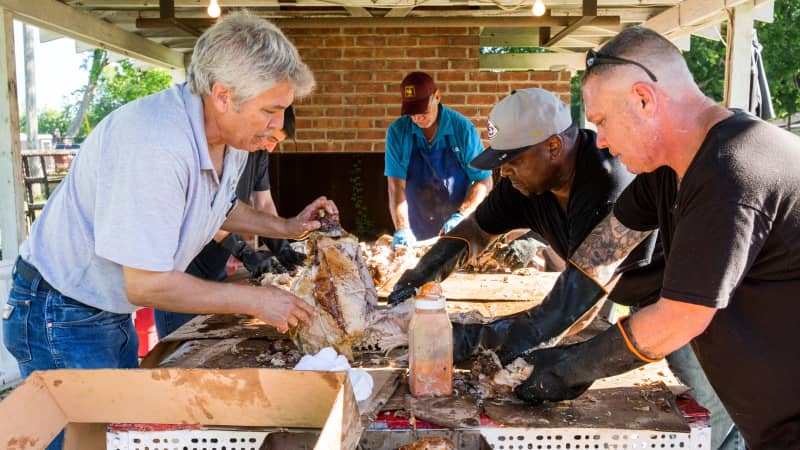
Local grocery store owner and festival organizer Ronnie Durant guided his crew through the process of separating the skin from each large hunk of still-steaming pork spread over a large table, pulling tender areas of the shoulder and ribs into long strands and cutting larger sections of white meat into bite-sized pieces.
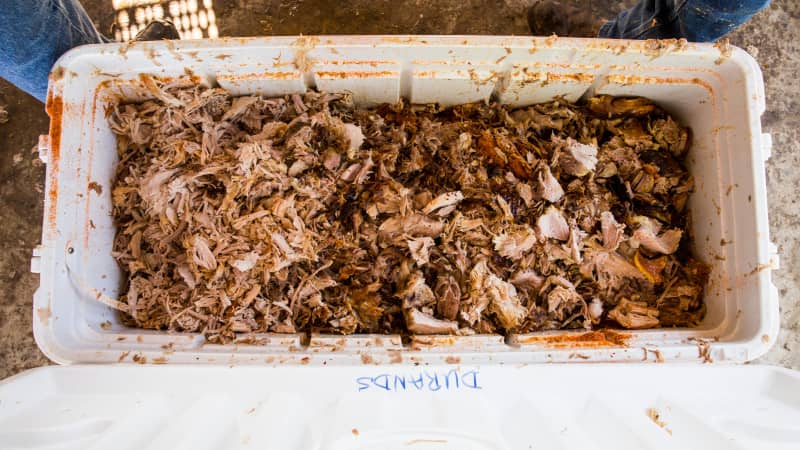
From there, workers moved the meat handful by handful into large insulated coolers to keep warm, applying a heavy red-orange sprinkle from a bottle of Cajun seasoning after every dozen handfuls or so. When a cooler couldn’t hold any more spiced roast pork, it was latched shut and hoisted onto the back of a utility vehicle for transportation down the driveway to the main pavilion to be served with hundreds of plate lunches packed with other local favorite side dishes.
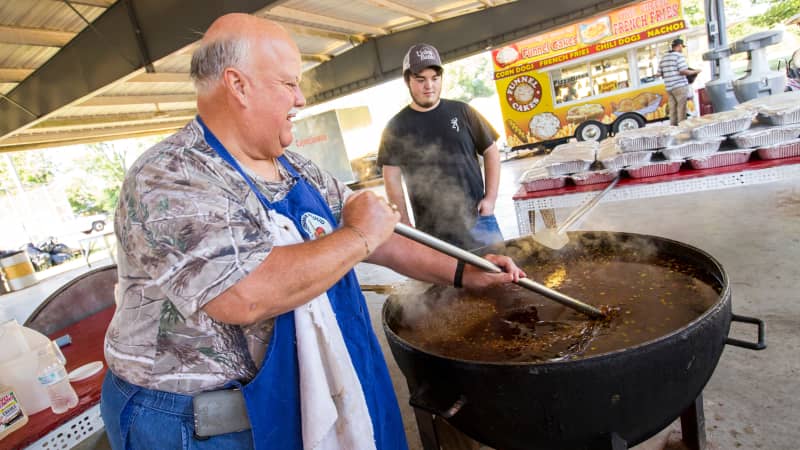
One such side, Cajun-style rice dressing, was being prepared in a covered on a covered patio behind the Cochon de Lait Center. Jimmy Armand and Ty Rachal tended to a stew-like mixture of spiced ground beef, garlic, scallions, onions, peppers, and stock in a huge cast iron kettle placed over a propane burner, using large metal paddles to keep things moving in the brown, savory depths before adding cooked white rice sitting in disposable aluminum pans on a nearby table.
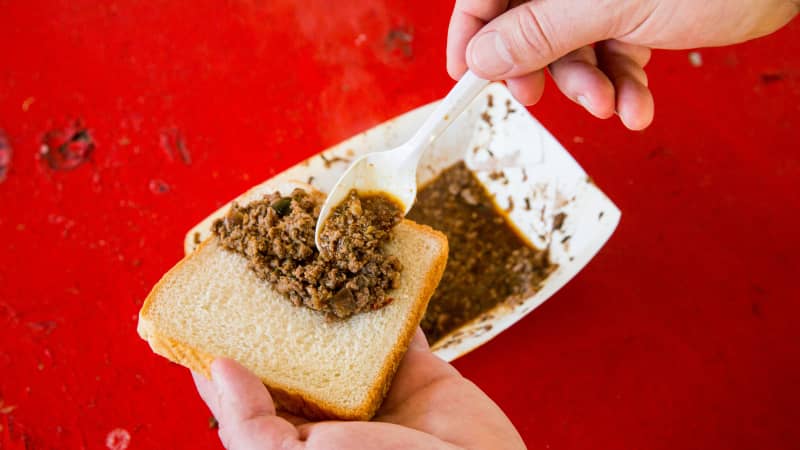
Tasting the stock mixture (the “yum-yum,” as Armand called it) was key to knowing when to add the rice. The preferred tasting medium among rice dressing aficionados: grabbing the nearest slice of white bread, and making a yum-yum sandwich—deeply rich and meaty with a slight cayenne kick.
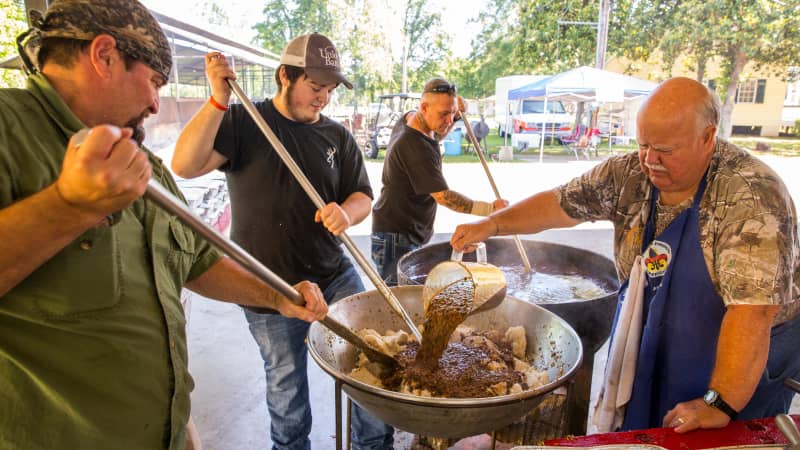
Only when the yum-yum had reached an approved thickness was it time for a trio of helpers to wheel in a metal bowl set on a cart, fill it full of rice, and set to paddling everything together as Armand dumped in pitcher after pitcher of beef-rich liquid. Giving the bowl a hard stare after each addition, Armand judged by sight when the dressing was finally done, calling over still more support staff for help transferring the finished product inside for service.
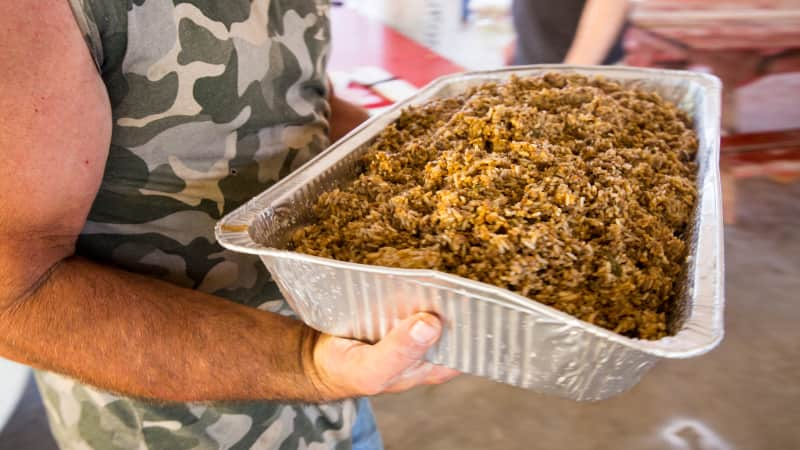
One by one, the pans that had one held the plain cooked rice were packed with the newly-mixed dressing, transformed into something darker, headier, spicier, and fully satisfying.
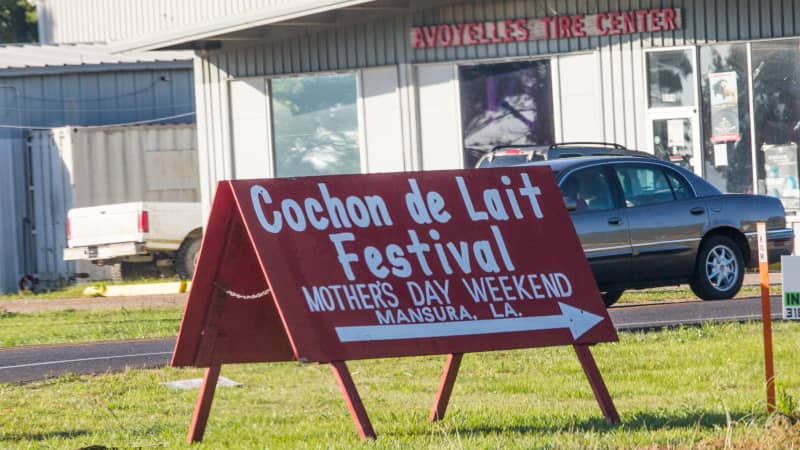
With all the components complete, it was finally time to assemble the plate lunches. Just after ten in the morning, cars began to pull into the lot outside the Cochon de Lait Center as those who had purchased tickets for plates ($9 apiece, available in advance at Mansura Town Hall) came to pick up their Sunday feasts.
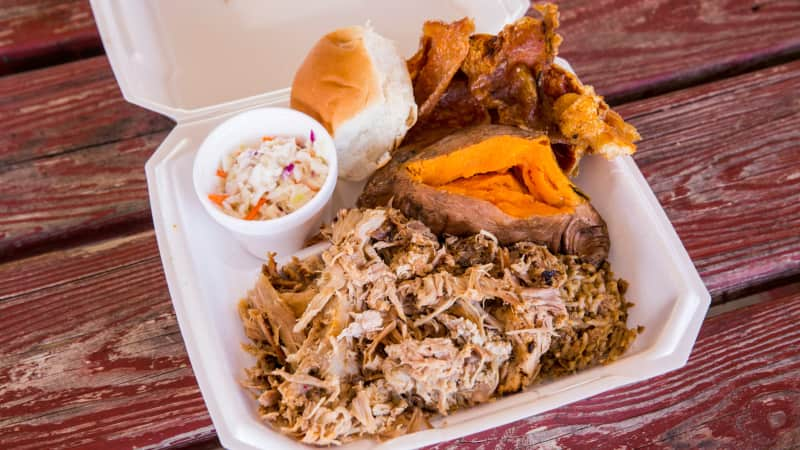
For just under a Hamilton, attendees were rewarded with a huge pile of slow-roasted pork atop two good-sized scoops of rice dressing, a baked sweet potato, slaw, a roll, and several index card-sized sheets of crisped pig skin. Not a bad haul, if I do say so myself.
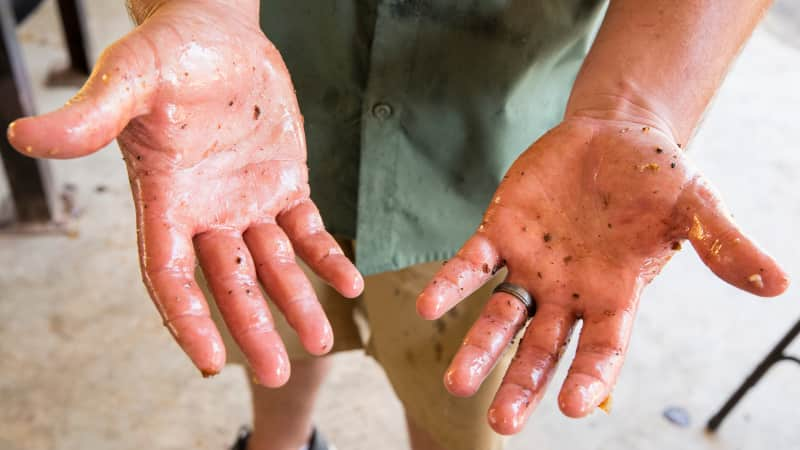
On the way out of the Cochon de Lait Festival, I ran into Zack St. Romain, who looked every bit the man who had spent all night roasting pigs: wild-eyed, wearing the same smoke-smelling clothes as yesterday, and covered from the wrists down in pork fat. As I bade him goodbye, he shouted after me, “If you ever got anyone who needs help getting a ring off, tell ‘em to come down and pick hogs for a couple hours.” I laughed, knowing that after what I’d seen in Mansura over the past twenty-four hours, it wouldn’t take much more than that to convince anyone to come take part in this singular experience of Cajun culture.